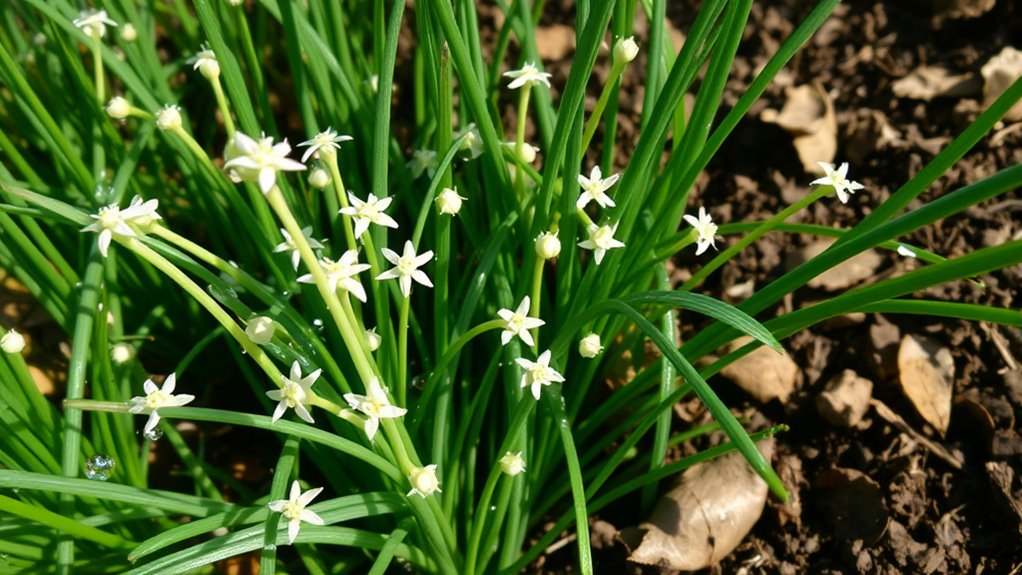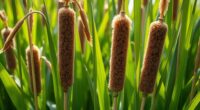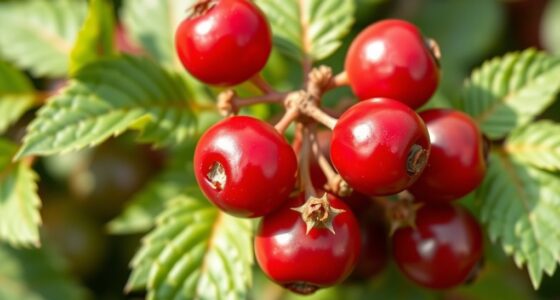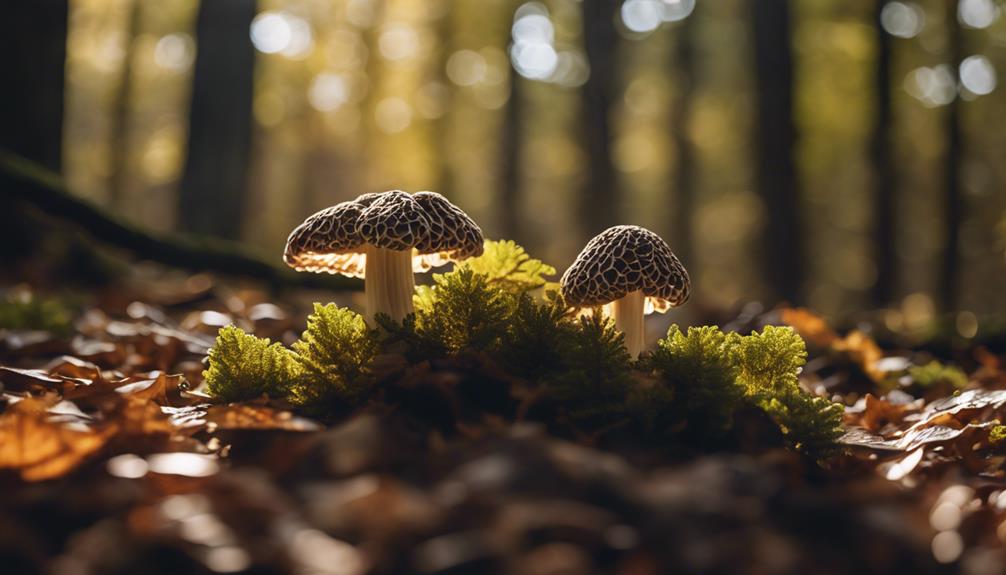Wild onions are easy to identify by their thin, waxy, hollow leaves with a strong onion or garlic scent when bruised. Look for clusters of narrow, dark green leaves up to 18 inches tall, with white to pinkish bell-shaped flowers in spring. Use scent and taste to differentiate them from lookalikes like death camas. Knowing their growth and uses helps harvest responsibly and enjoy their culinary benefits. Discover more about their fascinating features and eco-role ahead.
Key Takeaways
- Wild onions are identifiable by their hollow, bluish-green leaves with a strong onion or garlic scent when bruised.
- They grow from underground bulbs, produce clusters of small white or pinkish flowers in spring, and are harvested early for flavor.
- Proper identification involves sensory cues: a pungent smell and a sharp taste, distinguishing them from toxic lookalikes like Death Camas.
- Wild onions are versatile in cooking, used in sauces, soups, and as a fresh ingredient, while also supporting pollinators and soil health.
- Sustainable harvesting and management practices are essential to prevent overharvesting and control their invasive potential.
Recognizing Wild Onion: Distinctive Features and Visual Cues

To recognize wild onion, start by examining its physical features and visual cues. The plant grows from underground bulbs, making complete removal essential to prevent regrowth. Its narrow, dark green leaves resemble grass, especially in early spring, which can cause confusion. The leaves are hollow and have a waxy texture, and the plant can reach up to 18 inches tall. In spring, look for small, nodding, bell-shaped flowers that are white to pinkish, although these may be less visible in mowed areas. Wild onion often thrives in lawns and gardens, surviving poor soil and herbicides. Its strong onion-like smell when crushed is a key identifier, along with its taste. Recognizing these features helps distinguish wild onion from other similar plants. Additionally, understanding the plant’s growth habits and preferred habitats can aid in its identification and removal. Awareness of plant morphology can further assist in correctly identifying wild onion and avoiding confusion with similar species.
How to Differentiate Wild Onion From Poisonous Lookalikes

While the visual cues of wild onion are helpful, distinguishing it from poisonous lookalikes like Death Camas requires careful attention to botanical features, odors, and growth habits. Wild onions have hollow, cylindrical leaves often with a bluish tint, and their bulbs are pink or purplish. In contrast, Death Camas features flat, strap-like leaves that are green or yellowish, with white or cream-colored bulbs. A key difference is odor: wild onions emit a strong onion smell when crushed, while Death Camas has no noticeable scent. Additionally, wild onions produce purple or white flowers in clusters, blooming in late spring or early summer. Recognizing these specific characteristics helps prevent misidentification and ensures safe foraging. Paying attention to the plant’s growth habits and habitat can also aid in correct identification and avoid dangerous mistakes. Being familiar with the botanical differences between edible and toxic plants is essential for safe foraging practices. Educating yourself about plant identification techniques can further enhance safety during foraging endeavors. Furthermore, understanding the locational preferences of wild onions versus lookalikes can provide an additional layer of identification accuracy. A thorough knowledge of proper foraging methods and careful observation are crucial in safely harvesting wild onions.
The Role of Odor and Taste in Identification

The strongest way to identify wild onions safely is by relying on their distinctive odor and taste. You’ll notice a strong onion or garlic smell, especially when the plant is bruised or crushed. If the smell is weak or absent, it could be a lookalike or non-edible plant. A sensory-based identification method is essential because visual cues alone can be misleading, especially when plants are in different stages of growth. The taste should be sharp, with a clear onion or garlic flavor, which often intensifies as you sample it. Some species, like perennial leeks, have a more potent flavor, while others are milder. Always smell the plant first, then taste a small amount. Both cues together help you distinguish edible wild onions from poisonous lookalikes. Don’t rely on appearance alone—sensory confirmation is your safest guide when foraging. Additionally, understanding the plant’s growth habit can help ensure correct identification and safe foraging practices. Recognizing the plant’s lifecycle and seasonal development can further improve your accuracy in wild onion identification, especially in different environments. Being familiar with the local flora can also help you differentiate wild onions from similar-looking but inedible plants. Incorporating organized foraging techniques can enhance safety and efficiency during wild edible plant collection.
Growth Patterns and Reproduction Methods of Wild Onions
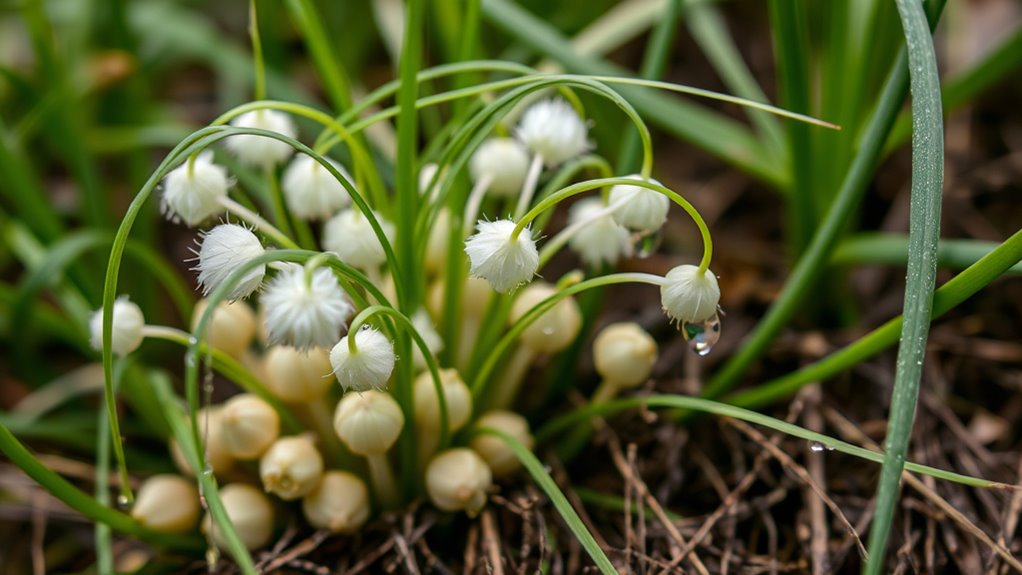
Wild onions grow primarily in clusters, which makes them easier to spot when foraging in the wild. They’re winter perennials, emerging in late fall from underground bulbs, and grow throughout winter and spring before dying back in early summer. You’ll notice their thin, green leaves—flat and solid, unlike hollow wild garlic leaves. They adapt well to various environments, tolerating full sun or partial shade, especially afternoon shade. They need consistent moisture and well-draining soil, thriving in loam, leaf mold, or sandy mixes. Wild onions reproduce mainly through underground bulbs, which persist in the soil and develop over years. They also produce aerial bulblets in late spring, which can drop and form new plants. Seeds are less common but can contribute to reproduction over time. Additionally, understanding their growth patterns can help foragers identify and sustainably harvest wild onions without damaging the ecosystem.
Exploring the Culinary Uses of Wild Onion
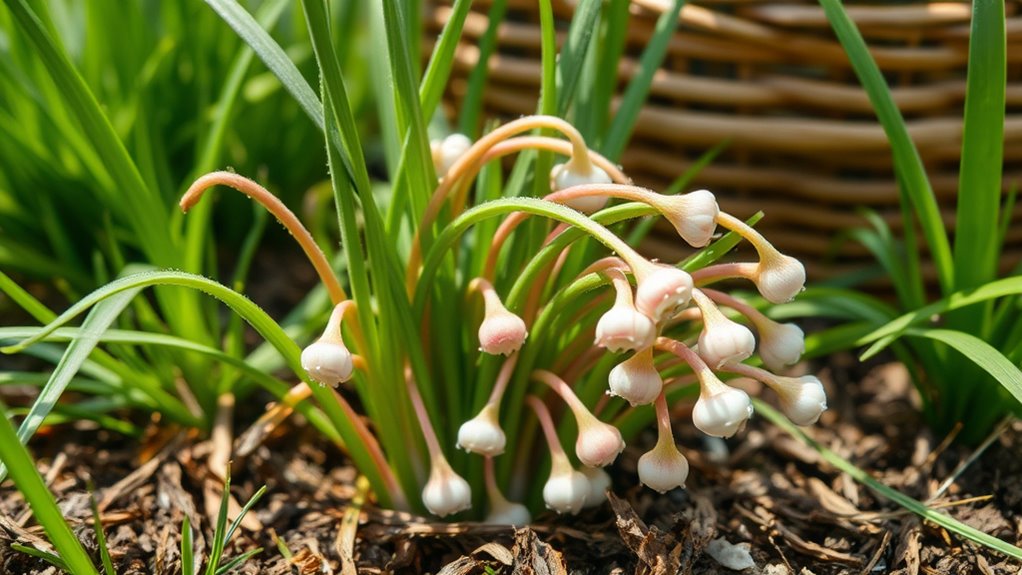
Wild onions are remarkably versatile in the kitchen, offering a range of flavors from sweet to pungent that can enhance many dishes. You can add them to sauces, like garlicky creamed sauce, for pasta or meat. They work well as a substitute for leeks or scallions, providing similar texture and flavor. Understanding their refrigeration cycle can help in storing them properly to maintain freshness. Use their green stems, flowers, or bulbils to add depth to soups and stews. In traditional cuisines, wild onions feature prominently—like in Italian pasta dishes or salads, adding a fresh, oniony kick. Properly identifying and harvesting wild onions is essential to avoid confusion with other plants, which can be a part of wild plant identification practices. To prepare them, sauté with garlic, wilt in butter, or roast to bring out their natural sweetness. Their seasonal availability in spring makes them a perfect ingredient for fresh, hearty dishes, enriching flavors while providing nutritional benefits like vitamins A and C. Additionally, plant foraging safety is crucial when collecting wild onions to ensure accurate identification and avoid toxicity. Being aware of local regulations regarding harvesting wild plants can also help prevent legal issues and promote sustainable foraging practices. Incorporating these edible wild greens into your diet can also be a sustainable choice that supports environmental conservation efforts.
Managing Wild Onion in Your Garden and Lawn
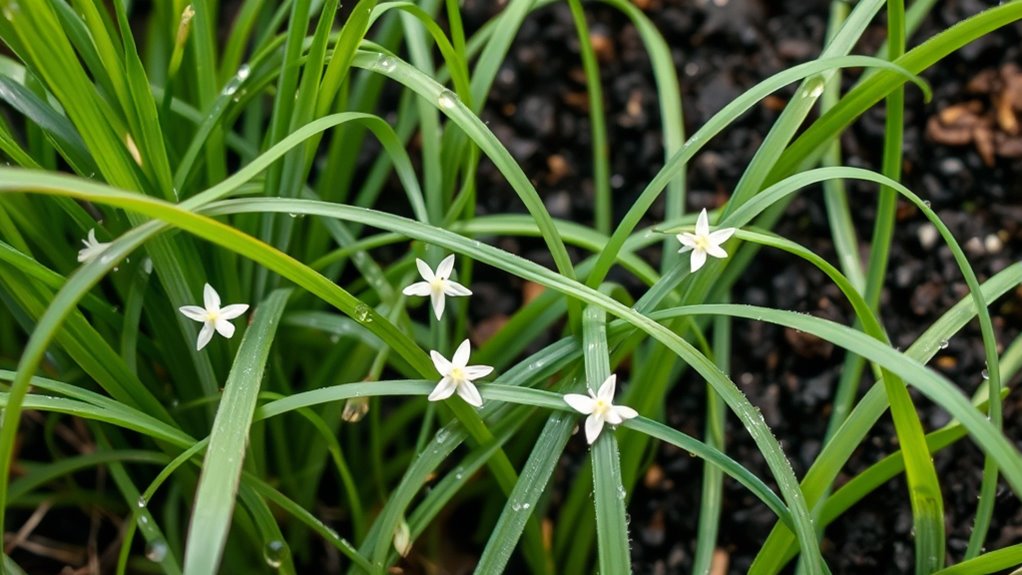
Managing wild onion in your garden or lawn requires a strategic approach to keep these persistent plants at bay. Since they’re perennials that grow from underground bulbs, regular maintenance is key. Mowing can weaken them by preventing bulb formation, but it won’t eliminate them completely.
Managing wild onion requires regular maintenance and strategic removal methods.
Hand pulling or using weeding tools can be effective for young plants, though the brittle leaves make removal tricky. Applying spot treatments with selective herbicides containing 2,4-D, MCPP, dicamba, or triclopyr during active growth phases helps control established weeds. Additionally, understanding the risks associated with new payment technologies can inform how you choose and manage your weed control methods responsibly. Incorporating weed suppression techniques such as proper mulching can further reduce wild onion proliferation.
Maintaining a healthy, dense turf through proper fertilization, overseeding, and watering supports weed prevention. Mulching garden beds with a two- to three-inch layer also suppresses wild onion growth. Using appropriate herbicides at the right time enhances control and reduces the need for repeated treatments. Employing integrated weed management strategies that combine cultural, mechanical, and chemical methods increases effectiveness and sustainability. Proper soil health and weed control timing are essential for long-term management success.
Combining physical removal with targeted chemical treatments offers the most effective management strategy.
Ecological Benefits and Challenges of Wild Onion
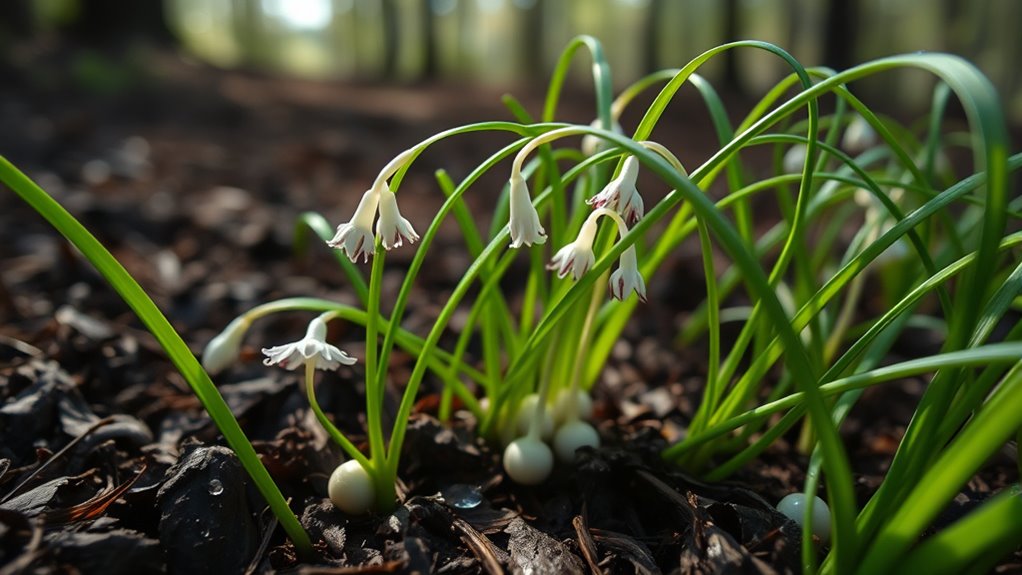
While wild onion can be considered a pesky weed in gardens, it also plays an important role in supporting local ecosystems. It attracts bees, butterflies, and hummingbirds, boosting pollination and biodiversity. Wild onion provides food for wild turkeys and supports soil health through active roots that promote nutrient cycling. It acts as a natural pest repellent and helps maintain ecosystem balance by offering shelter and food for various animals. Additionally, its presence can foster environmental resilience by contributing to the stability and recovery of native habitats. Its ability to spread rapidly makes it a controlling invasive species, which can outcompete native plants and disrupt local plant communities. However, wild onion also poses challenges. It can be toxic to livestock if eaten excessively and may cause low toxicity in humans if misidentified. Its aggressive growth can outcompete native plants, making it a weedy invader. Its similarity to other plants increases the risk of misidentification, complicating management efforts. Furthermore, understanding its native range is essential for assessing its ecological impact and developing effective control strategies. Recognizing its adaptive traits can aid in managing its spread and mitigating its ecological impact.
Best Practices for Harvesting and Using Wild Onion Safely
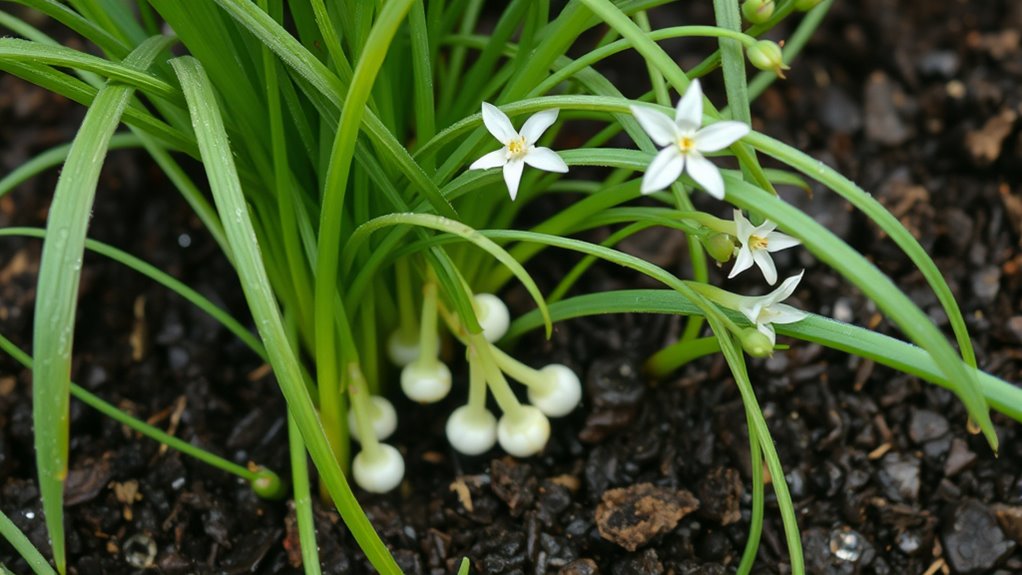
To harvest wild onion safely and sustainably, it’s important to carefully identify the plant and follow best practices to minimize environmental impact.
Look for thin, waxy, spear-like leaves in clusters and check for a distinctive onion or garlic smell when bruised. Make sure it doesn’t resemble toxic look-alikes, which lack this scent.
Harvest only the largest onions to reduce habitat disturbance and use a garden trowel or fork to loosen the soil before pulling bulbs, especially in hard soil.
Limit your collection to 10-20% of a patch to promote regrowth. Harvest in early spring for the best flavor, and cut the base with scissors for cleaner removal.
Always respect local regulations and avoid overharvesting to protect wild onion populations.
Wild Onion: An Invasive Species or a Natural Treasure?
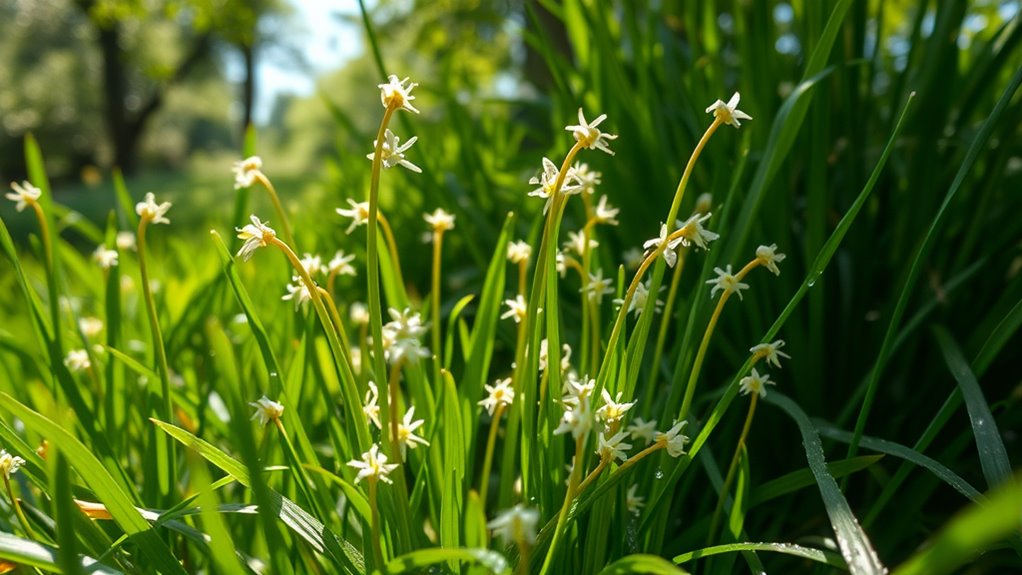
Wild onions are common finds in many North American landscapes, but their presence often sparks debate about whether they’re a valuable native plant or an invasive threat. Some species, like *Allium canadense*, are native and beneficial, supporting local ecosystems and soil health.
However, others, such as *Allium vineale*, can spread aggressively, outcompeting native plants and altering habitats. Their ability to regrow from small parts makes control difficult, especially in lawns and disturbed areas.
Despite their invasive potential, wild onions also provide food for wildlife and have cultural, culinary, and medicinal uses. Whether viewed as a natural treasure or a problematic invader, understanding their regional distribution and ecological impact helps you manage them responsibly and appreciate their role in nature.
Frequently Asked Questions
Can Wild Onions Be Safely Consumed During All Growth Stages?
You might wonder if wild onions are safe to eat at every growth stage. The good news is, yes, you can enjoy them year-round, especially their bulbs underground.
During spring, new shoots and leaves are safe to harvest, and even aerial bulblets are edible.
Just make sure they smell like onions and aren’t in polluted areas. Avoid consuming plants without the characteristic onion smell to stay safe.
Are There Any Medicinal Benefits Associated With Wild Onion Consumption?
Imagine biting into a wild onion, feeling its sharp flavor and aroma awaken your senses. You mightn’t realize it, but this plant offers powerful medicinal benefits.
Wild onions have antibiotic, anti-inflammatory, and antiviral properties that help fight infections, reduce inflammation, and support your immune system.
They also promote heart health, aid digestion, and may even help prevent certain cancers, making them a natural remedy packed with health-boosting nutrients.
How Can I Effectively Prevent Wild Onion Regrowth After Removal?
To prevent wild onion regrowth after removal, you should regularly monitor your garden and act quickly when you see new shoots.
Use a combination of methods like hand pulling, digging out bulbs, and applying mulch or dense groundcover to block sunlight.
Mow your lawn frequently, and consider using targeted herbicides or homemade vinegar sprays.
Consistent maintenance and vigilance will help keep wild onions from returning.
Do Wild Onions Have Any Impact on Local Pollinator Populations?
You might wonder if wild onions affect local pollinator populations. They actually attract various pollinators like bumblebees, supporting biodiversity and ecosystem health.
However, habitat loss, pollution, and climate change threaten these pollinators, which can reduce wild onion pollination success.
What Are the Best Native Plants to Pair With Wild Onions in a Garden?
Imagine you’re planting a medieval herb garden, where native plants thrive alongside wild onions. You should consider marigolds to repel pests, borage to attract beneficial insects, and radishes to break up soil.
Chives, being in the same allium family, enhance pest deterrence. These plants support your wild onions by improving soil, attracting pollinators, and keeping pests at bay, creating a resilient, thriving garden ecosystem.
Conclusion
Wild onion is a versatile gem hiding in plain sight, like a secret treasure beneath your feet. With a keen eye and a gentle sniff, you can uncover its culinary magic while respecting its wild spirit. Whether you see it as a garden friend or an invasive challenge, remember it’s a living piece of nature’s puzzle. Embrace its wild charm, and let it add flavor and wonder to your outdoor world.

